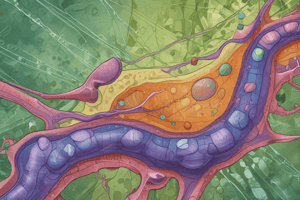Podcast
Questions and Answers
What is the main function of tight junctions?
What is the main function of tight junctions?
- Allowing passive diffusion across epithelial layers
- Enabling electrical and metabolic coupling between adjacent cells
- Facilitating rapid exchange of small signaling molecules
- Creating a seal around adjacent cells to prevent fluid flow (correct)
Which type of junction allows direct electrical and metabolic coupling between adjacent cells?
Which type of junction allows direct electrical and metabolic coupling between adjacent cells?
- Tight junctions
- Desmosomes
- Gap junctions (correct)
- Adherens junctions
What is the role of gap junctions in cellular interactions?
What is the role of gap junctions in cellular interactions?
- Creating a seal around adjacent cells to prevent fluid flow
- Facilitating rapid exchange of small signaling molecules (correct)
- Maintaining tissue integrity
- Preventing passive diffusion across epithelial layers
Which junction forms a fence-like barrier that restricts paracellular transport?
Which junction forms a fence-like barrier that restricts paracellular transport?
Which type of junction serves as a selective barrier preventing passive diffusion across epithelial layers?
Which type of junction serves as a selective barrier preventing passive diffusion across epithelial layers?
What is the primary function of hemidesmosomes?
What is the primary function of hemidesmosomes?
What kind of junctions connect neighboring cells through transmembrane cadherin receptors binding intracellularly to catenin proteins?
What kind of junctions connect neighboring cells through transmembrane cadherin receptors binding intracellularly to catenin proteins?
Which junction generates mechanical tension due to its association with actomyosin networks?
Which junction generates mechanical tension due to its association with actomyosin networks?
What type of cell junction binds basal epidermal cells to the underlying extracellular matrix?
What type of cell junction binds basal epidermal cells to the underlying extracellular matrix?
Which type of cell junction mediates strong, noncovalent interactions between keratin intermediate filaments anchored in the cytoplasmic plaque?
Which type of cell junction mediates strong, noncovalent interactions between keratin intermediate filaments anchored in the cytoplasmic plaque?
Which cell junction collaborates with other elements to create a highly integrated network and confers stability upon epithelial sheets subjected to shearing forces?
Which cell junction collaborates with other elements to create a highly integrated network and confers stability upon epithelial sheets subjected to shearing forces?
Which type of junction is essential for signal transduction pathways related to morphogenesis, cell polarization, and immune responses?
Which type of junction is essential for signal transduction pathways related to morphogenesis, cell polarization, and immune responses?
Flashcards are hidden until you start studying
Study Notes
Cell Junctions: Bridging Cells Together
Cells do not exist in isolation; rather, they form dynamic, complex structures called tissues through specialized connections known as cell junctions. These junctions ensure communication between cells, maintain tissue integrity, and regulate various biological processes such as migration, differentiation, and maintaining the polarity of cells within an organism. In this exploration, we focus on five primary types of cell junctions – tight junctions, gap junctions, adherens junctions, desmosomes, and hemidesmosomes – each playing distinct roles in sustaining life and structure.
Tight Junctions (TJs)
Tight junctions serve as selective barriers preventing passive diffusion across epithelial layers while allowing specific molecules to pass. They create a seal around adjacent cells and prevent fluid flow by forming strands of proteins like claudin and occludin, which intertwine with one another. This formation creates a fence-like barrier restricting paracellular transport.
Gap Junctions (GJ)
Gap junctions allow direct electrical and metabolic coupling between adjacent cells via protein channels formed primarily from connexins. This molecular passageway enables rapid exchange of small signaling molecules among cells, facilitating coordinated interactions during developmental stages and maintaining homeostasis.
Adherens Junctions (AJs)
Adherens junctions connect neighboring cells through transmembrane cadherin receptors binding intracellularly to catenin proteins. AJs generate mechanical tension due to their association with actomyosin networks, contributing to tissue stiffness and stability. Additionally, these junctions participate in signal transduction pathways essential for morphogenesis, cell polarization, and immune responses.
Desmosomes
Desmosomes function similarly to adherens junctions but differ structurally and mechanically. They mediate strong, noncovalent interactions between keratin intermediate filaments anchored in the cytoplasmic plaque. Desmosomes have high tensile strength and contribute significantly to cohesion and resistance to mechanical stress experienced by stratified and columnar epithelia.
Hemidesmosomes
Hemidesmosomes bind basal epidermal cells to the underlying extracellular matrix. Integrin adhesion receptors anchor cytoskeletal components within the cell's interior and interact with laminin in the basement membrane below, conferring stability upon epithelial sheets subjected to shearing forces.
While all five forms of cell junctions play critical roles in upholding tissue organization and functioning, they also collaborate with other elements, such as the extracellular matrix and contractile machinery, creating a highly integrated network. Understanding how cell junctions work will further our knowledge of fundamental biology and help guide new developments aimed at treating diseases associated with abnormalities in cell junction formation, such as cancer, neurodegeneration, inflammation, and autoimmune disorders.
Studying That Suits You
Use AI to generate personalized quizzes and flashcards to suit your learning preferences.



